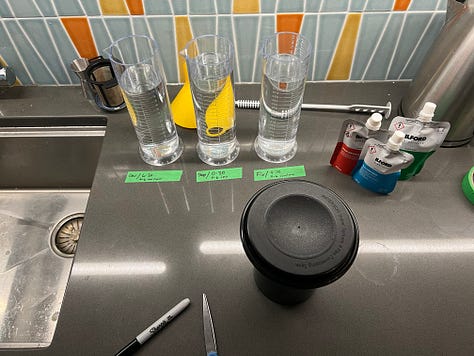


Ugh, I’m sick. Nothing serious, just a congestion-and-fatigue head cold that I’m sure will pass. But I’ve been lying low all weekend. In lieu of One Main Essay I’m going to do things a little differently around here and offer up a few kitchen-adjacent small bites.
Chicken Noodle Soup
A cold requires soup. I don’t have a single go-to chicken soup recipe, because the right path is so dependent on what you have around the house. If you have a couple quarts of good quality stock — lucky you — then there isn’t much to do. Poach a couple of chicken breasts in there, add some vegetables, and you’re done. If you roasted a chicken last night and want to make soup from the remains, that’s a totally different thing. Or maybe you want to doctor up some mediocre boxed stock. It can be done!
In the case of truly starting from zero, I’m a fan of the method in this Molly Baz recipe published in BA in 2020. You start by poaching a whole chicken in regular water, taking out parts as they are done. It yields an exceptionally rich broth and a whole lot of shredded chicken. It really is a generous soup.
There are a couple of things I do differently:
Break the chicken into parts before poaching. The original recipe calls for you to add the whole chicken to the pot, pull it out after 25 minutes of simmering to remove the cooked breast meat, and then add the remains back to the liquid. Do not do that. It’s a steamy mess, and you’re going to wind up dripping not-fully-cooked chicken liquid all over your stove and counter. Instead, break the chicken down before goes into the pot, so that you can pull the breast when it is ready and leave everything else happily simmering away. Breaking the chicken into parts is easy — you’re a just sharp knife and a YouTube tutorial away. You don’t even need to do a great job since you’re just going to shred up all the chicken in the end anyhow.
Don’t cook the noodles in the stock: If you just spent all that time making a rich, golden stock, I don’t understand why you would dump a bunch of ditalini in there to cloud everything up. Instead, just wipe out the stock pot from making your broth, boil some water, and cook the pasta in there. Maybe this is my Induction Stove Privilege talking, but this hardly adds any cooking time or fuss, and it really does make the end product better.
Even if you’re not sick, this is a great thing to make. If you’re in Victoria, The Root Cellar currently has whole chickens on sale, so it’s pretty economical too.
NA Beverage Delivery
Someone mentioned Fizz Bottle Shop — a new non-alcoholic beverage delivery service — to me about a week ago, and then I wound up walking by their popup space on Johnson street on Wednesday. Unfortunately I didn't have time to go in, but it looked very nice.
This is a great idea. The delivery model is a smart place to start, and the selection is great. They have Ghia, which I have written about before. I think Ghia will be hitting Victoria big time in 2025. They also have the St. Agrestis mocktails, including the bafflingly good Phony Negroni. (I love to drink a Negroni, but the combination of sugar and booze inevitably makes me feel disgusting. Flavor-wise, the St. Agrestis version is not in any way a compromise. It’s unsettling how much this tastes like a full-strength Negroni.) They also have lots of NA drinks I’ve never heard of, some lovely glassware, and a very pretty website to boot!
I’m currently working my way through a bunch NA-cans that I bought at The Market Garden, but I plan to put in an order from Fizz soon. I suspect this will do well.
Developing Film in the Kitchen
I’m not a particularly good photographer, but I love to shoot film. Unfortunately, Victoria lost its last black and white lab a few years back, which means that the only ways to develop black and white film are to send it to Vancouver or do it yourself.
I like to do it myself. My condo building has a light-tight room in the basement that I use to transfer film to a tank, and then I use my regular kitchen to do the development. Don’t worry, I clean up extremely well afterwards.
Unlike almost everything else that happens in my kitchen, developing film is completely mysterious to me. You add some liquids in the right order, you shake the tank around, and developed film comes out. What do the liquids do? I know the basics: the developer develops the image, the fixer fixes the image. How do they work? I have no idea. I can’t really improvise or fix mistakes, I just follow the recipe and hope for the best.
I realize that for a lot of people that is what cooking is like. I’ve spent a lot of time learning about why cooking works, which means that I can spot and fix problems. If a cake sinks in the middle it’s disappointing, but I know how to play around with the leavening next time to improve. I’m sure that some people have this knowledge about developing film, but I don’t know that I’ll ever have the time or inclination to cultivate it. Plus, being an amateur has its own pleasures; every time I open the tank and see developed images it feels like genuine magic.





hope you are feeling better!
Photos and chicken and soda... oh my! but it all works.